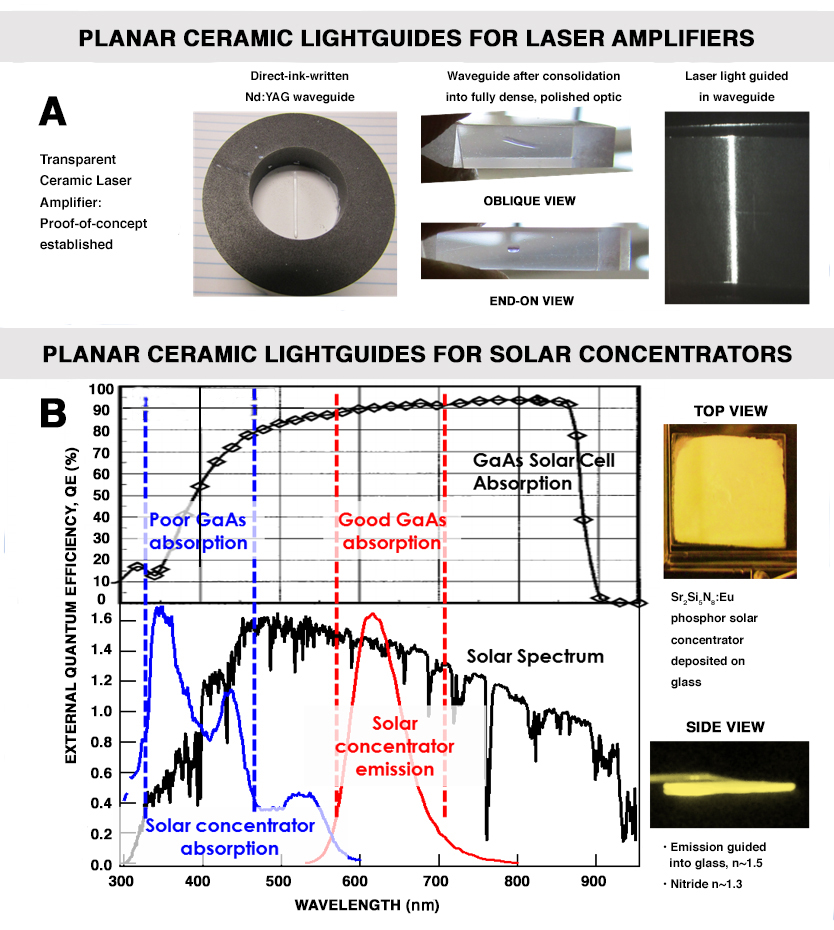Nerine Cherepy (17-ERD-114)
Executive Summary
We intend to use direct ink-writing techniques to fabricate transparent ceramic light-guide structures that will produce low optical scatter and high light confinement. These structures have potential applications in high-efficiency solar panels and enhanced waveguide laser amplifiers, which are relevant to the DOE goals in national and energy security.
Project Description
We are developing a direct ink-write process to produce spatially controlled ceramic green bodies, subsequently sintered into transparent ceramic light-guide structures. A green body’s main constituent is weakly bound ceramic material, usually in the form of bonded powder or plates before it has been sintered or fired. These green bodies possess the low optical scatter and high light confinement required for a variety of uses, including high-performance luminescent solar concentrators for photovoltaic devices such as solar panels, and waveguide laser amplifiers. While gallium arsenide solar cells offer the highest efficiency for a single-junction cell, they are costly on a per-area basis, and thus suited to a concentrator design. An alternative to lenses is the luminescent solar concentrator, a large-area optically transparent plate in which the broadband diffuse solar spectrum is absorbed by dispersed luminophores (a functional group in a chemical compound that is responsible for its luminescent properties). Absorbed light is re-emitted to longer wavelengths and coupled by total internal reflection to the edges of the collector plate. A waveguide laser amplifier design, in which at least one dimension is intended to operate in a natural single mode, offers enhanced optical gain, low lasing threshold, passive mode control, and excellent thermal management in a small footprint. However, planar waveguide lasers for higher-power applications, based on crystalline laser gain materials, are currently difficult to fabricate. The conventional method of diffusion bonding requires an extremely perfect polished surface to be produced on very-thin single crystals, which are then bonded by holding them in a specialized compression fixture while heating.
If successful, this project could provide a new route to high-efficiency solar collectors, using rugged transparent ceramic plates as sunlight “antennae” concentrating diffuse solar radiation into a narrow red emission efficiently converted by gallium arsenide solar cells. Use of proposed transparent green-body ceramics may allow higher concentration efficiency and stability to be achieved than the current state-of-the-art using plastics, at a lower fabrication cost, thereby decreasing the cost of photovoltaic installations. Our proposed ceramic green bodies could also enable an enhanced waveguide laser amplifier that would reduce the footprint for high-power lasers. We expect to fabricate composite ceramics using commercial aluminum, oxygen, and nitrogen (aluminum oxynitride) powder and oxynitride phosphor powders to create a green body ceramic using cold-pressing as well as direct ink-writing techniques. We will characterize the optical performance and optimize the composition to permit efficient guiding of light over a 1-cm length. In addition, we will fabricate layered ceramics with existing yttrium aluminum garnet and neodymium-doped yttrium aluminum garnet powder to create ceramic green bodies. We intend to fabricate a waveguide structure using a dual-head direct ink-write system to form a green body with an neodymium-doped planar layer within an undoped yttrium aluminum cylinder, followed by ceramics processing including calcination, sintering and hot isostatic pressing, cutting, and polishing to a cuboid shape.
Mission Relevance
Creating new materials, such as the proposed spatially controlled ceramic green bodies, supports the Laboratory’s core competency in advanced materials and manufacturing. Applications for enhanced luminescent solar concentrators for higher-efficiency solar collection systems could improve the nation’s energy security, in support of Livermore's energy and climate security mission focus area. New compact laser systems, such as the planar waveguide laser amplifier that employs green bodies sintered into transparent light-guide structures, have multiple applications relevant to national security, in support of the DOE goal to strengthen key science, technology, and engineering capabilities and modernize the national security infrastructure.
FY17 Accomplishments and Results
In FY17 we (1) fabricated thin-film phosphor coatings on high-index substrates and observed light guiding into the substrates; (2) obtained a specialized die, developed inks, and fabricated three direct-ink-write planar waveguides, using neodymium-doped yttrium aluminum garnet in a yttrium aluminum garnet ceramic (see figure); and (3) measured light guiding in the best one, though optical scatter was non-negligible.
I assume






